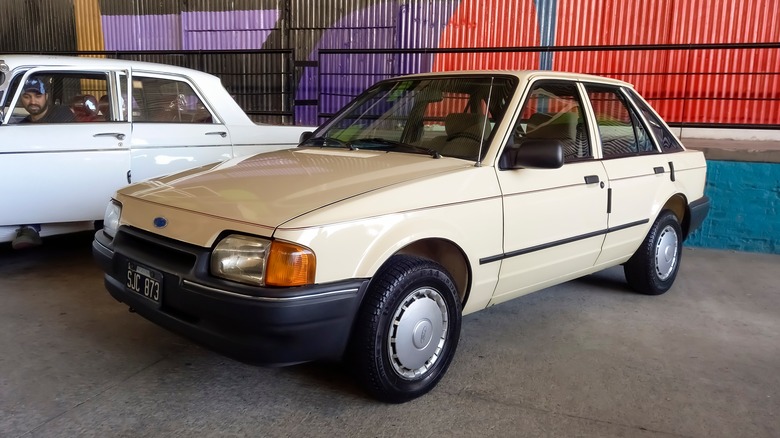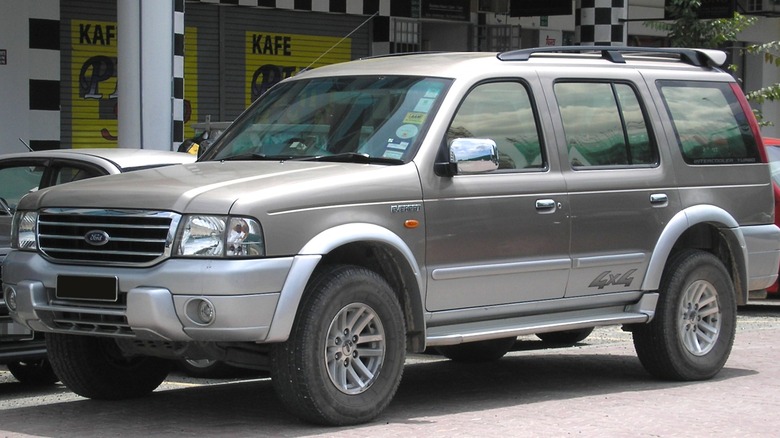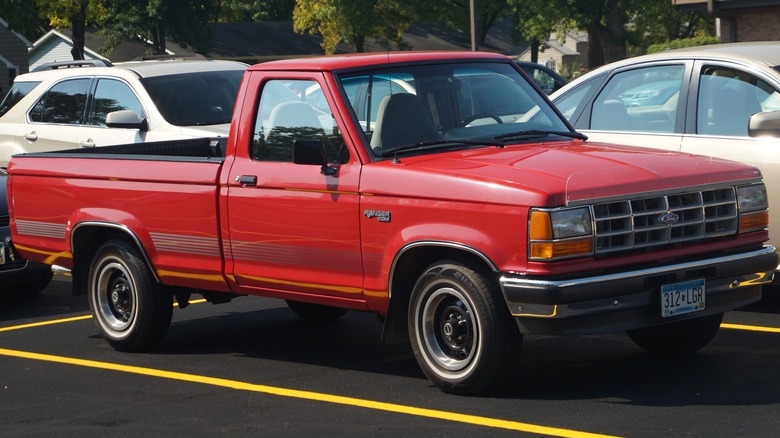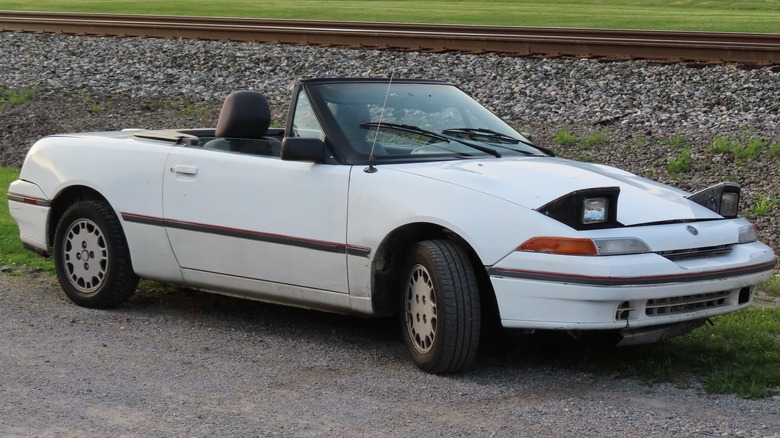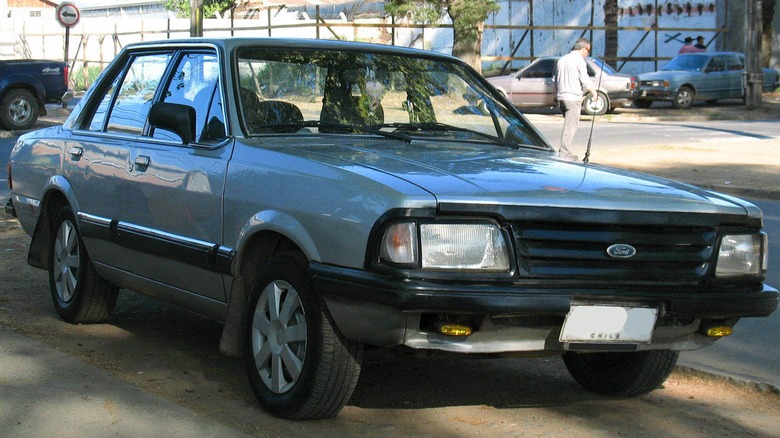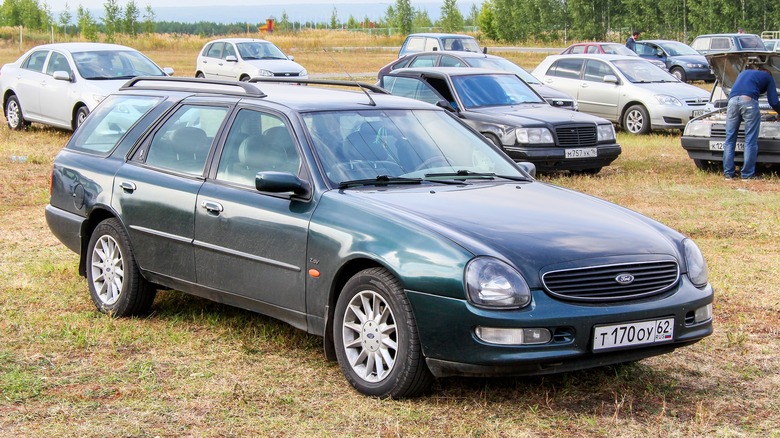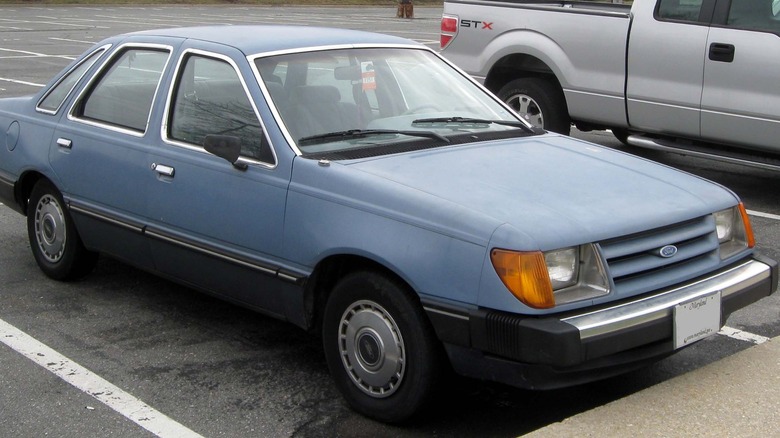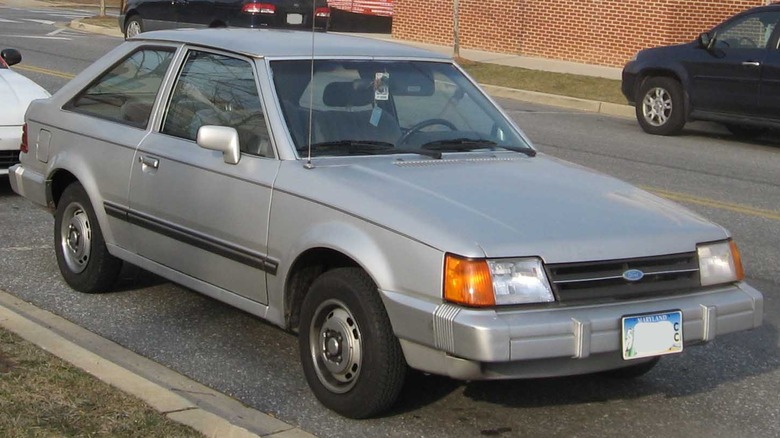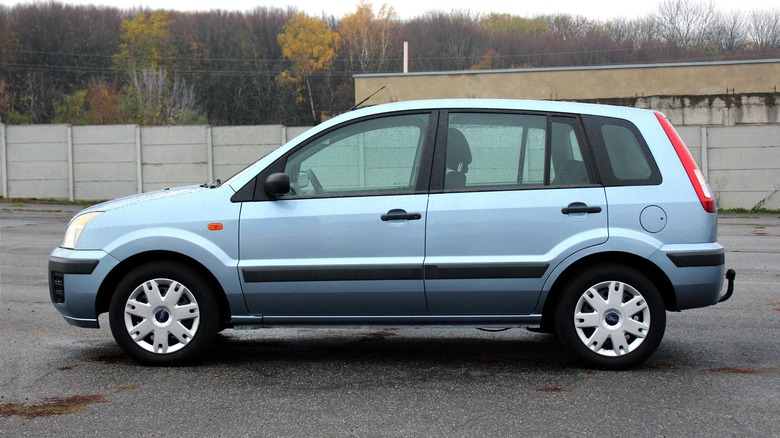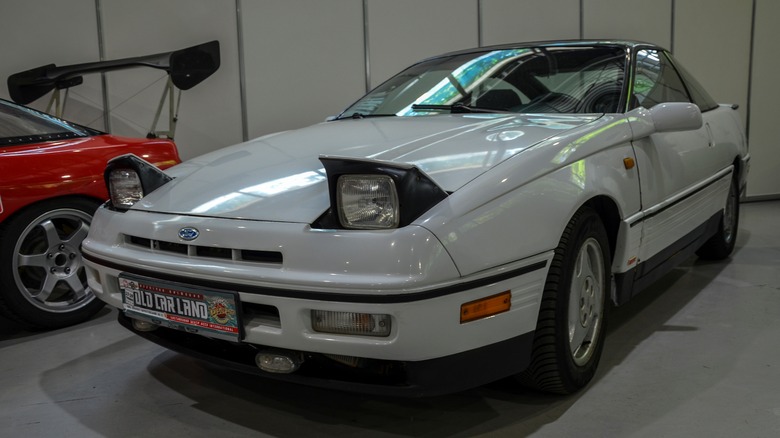10 Fords Powered By Non-Ford Engines
If not for its wide range of top-performance vehicles, Ford would surely be known for its incredible engine designs. The company has made use of these specialized engines countless times in the modern era, with its EcoBoost engine powering most Ford vehicles manufactures today. Even before the company's founding, Henry Ford was making engines as early as 1893. As such, those who haven't looked into Ford's history might be surprised to learn that there are some vehicles under its brand using engines made by other manufacturers.
Today, you're unlikely to find any brand-new Ford ride that doesn't have the company's own uniquely designed engine under its hood, but before the 2010s a few vehicles were produced with collaborative efforts from companies such as Mazda, Mitsubishi, and Volkswagen. These efforts usually led to non-Ford engines being placed inside Ford vehicles, sometimes serving as a diesel option and other times simply being an alternative gasoline choice. Die-hard fans and historians should keep these collaborations in mind, because even though they're powered by non-Ford engines, they're still Ford vehicles through and through.
Ford Everest (Mazda)
In its early years — from 2003 to 2006 — the Ford Everest offered buyers the chance to try out two different engines. One was a Ford-made 2.5-liter Duratroq engine, introduced by the company just a few years prior, while the other was Mazda's own 2.6-liter G6. The latter provided slightly higher power at the cost of less torque, though its presence vanished from the vehicle by the second generation. The Everest is still in production today, but all of its modern engines are specifically Ford-made.
Even if you want to check out an early Everest for yourself, you might have some difficulty getting that chance. The Everest is a Ford model you can't buy in America, so anyone in the U.S. should look overseas. Luckily, there are other options for fans of Mazda's engine designs, as the company has maintained a healthy relationship with Ford since the 1970s. The first-generation Everest is one of the latest examples of their collaborations, but it's far from the only one.
Ford Ranger (Mazda/Perkins and Mitsubishi)
In just the short period from 1983 to 1987, the Ford Ranger had an incredible number of companies working under its hood. Starting with its first model year, the Ranger had a diesel engine available from Mazda that was actually licensed out to them by Perkins, carrying the legacy of another classic Ford pickup that was actually a Mazda truck. A few years later, though, Ford spread out from Mazda's offering and provided an alternative diesel engine from Mitsubishi instead. Both of these engines fell out of favor by 1987, and later models had no diesel option.
Comparing the two engines, Mazda's had a capacity of 2.2-liters with 59 hp, while Mitsubishi's engine increased the size by an additional 0.1 liter and had a decent horsepower boost that climbed up to 86. These numbers were far from groundbreaking even in the early '80s, but the Ranger itself can still be safely described as one of the most reliable pickup trucks out there. Just don't expect to find one of these early models so easily. Even though it was originally available in the U.S., these older Ford Rangers are still rare today.
Ford Tourneo Connect (Volkswagen)
Perhaps the most recent example of a Ford vehicle with a non-Ford engine is the Tourneo Connect. In 2022, the company made an alliance with Volkswagen to create brand-new Tourneo Connects, and the engines inside are wholly made by the German manufacturer. This is in spite of the "EcoBoost" and "EcoBlue" branding present in the marketing, which is usually reserved for Ford's in-house creations. The Tourneo Connect is still in production today, making it the only current Ford vehicle to offer engines made by another company.
The Tourneo Connect is also yet another example of a Ford vehicle not available in the states. The Tourneo itself piggybacked off of the Ford Transit, the coolest van you can't buy in the U.S., providing very similar features and being seen by some as a direct successor. The Transit lacked the same collaborative efforts as the Tourneo Connect, though, preventing it from sharing a spot on this list with its newer counterpart.
Ford/Mercury Capri (Mazda)
In the United States, Ford released a number of its cars under a "premium" brand known as Mercury. This line lasted from the 1930s all the way to the 2010s, and among these high-end cars, the Mercury Capri happened to end up with a couple of Mazda engines. They were only available in the car's third generation, with one being a basic 1.6-liter B6D boasting 96 hp and the other being a turbocharged 140 hp version of the same engine. Ironically, it competed with Mazda's own line of Miata cars, though it didn't manage to last very far beyond this iteration.
This version of the Capri only happened to run from 1991 to 1994. Since then, the name had gone unused until very recently. Die-hard Ford fans might have already heard about how the Ford Capri is coming back, though this new version is an electric vehicle with seemingly no influence from Mazda whatsoever. However, it was reported that the new EV will be based on a Volkswagen platform, so you might still be able to expect some internal components that branch out from Ford's designs.
Ford Del Ray (Volkswagen)
The Del Ray was another case of Ford partnering with Volkswagen, with the vehicle bearing a 1.8-liter engine from the latter manufacturer during the early 1990s. This also happened to be around the time the Del Rey was discontinued and replaced, so Volkswagen's influence on the vehicle's powertrain didn't last very long. In fact, as it was only present starting in 1989, it might have the shortest run of any outside company's engine. Still, compared to its only other option, the 1.8-liter choice provided greater horsepower and torque, and the lesser 1.6-liter alternative wasn't even available by the car's final model year.
Like many other vehicles on this list, the Del Rey was only available outside of the U.S. In this case, it was only ever available in Brazil, so your chances of getting to see one outside of there are slim at best. Ford's collaboration with Volkswagen didn't end here, though, as you can see from the existence of the Tourneo Connect. The Del Rey was among the first cars these companies worked together on, helping to build a partnership that's still active today.
Ford Scorpio (VM and Peugeot)
The Ford Scorpio is one of the most unique vehicles on this list, as one of its powertrain choices comes from a company solely focused on engines rather than cars. Initially, the car manufacturer Peugeot provided the Scorpio's diesel engines once the vehicle was offered as a sedan in 1990. Not long after, though, an entirely different diesel offering made by VM Motori, an engine-only manufacturer, was introduced. This new engine provided greater horsepower than Peugeot's option, and it managed to last until the car's retirement in 1998.
The Scorpio was only meant for European markets, but it was briefly brought into the U.S. under the Merkur brand name. Unfortunately, this was before it received the non-Ford diesel engines, and many consider the Merkur to be a European car that was a huge mistake to release. Even the later models were received poorly, with the Scorpio's demise practically reshaping its business strategy. There aren't many records of Ford collaborating with Peugeot and VM beyond this example, and considering the Scorpio's failure, it's not hard to see why.
Ford Tempo (Mazda)
The Ford Tempo, much like the Scorpio, only had third-party options for its powertrain in the form of a diesel engine. Unlike the Scorpio, this engine was made by Mazda, and it was the only one available as part of the vehicle's first generation starting in 1983. This option was also quickly phased out when the Tempo received design changes in 1986. Interestingly, the Mazda-built diesel was also present in the Mercury Topaz, which acted as an alternate version of the Tempo with minor aesthetic changes.
The Mazda-built engine within the Ford Tempo didn't last very long, and neither did the Tempo itself. The fuel efficient Ford Tempo of the '90s was discontinued less than halfway through the decade, not much time after the car's diesel offerings were removed from its selection. Today, the car is unimpressive, with even the most pristine diesel versions just not being able to stand up against similar classic cars. Even so, it's an earlier example of a Ford collaboration with Mazda, tied with the Ranger as some of the oldest Ford vehicles to have a Mazda engine under the hood.
Ford Escort (Mazda/Volkswagen)
The Escort is one more landmark of history for Ford and Mazda's collaborations, with the latter's 2.0-liter diesel being offered as early as 1984. Things didn't stop just at another diesel engine, though, as non-diesel Escort models from over a decade later were still using powertrains held together by Mazda. This was the case for North America while Europe's version of the car relied almost entirely on Ford-made engines. However, alternative engines made by Volkswagen were present in these European models as well, making this a rare case of two different companies providing engines for Ford in different countries.
The Ford Escort is still in production today. However, not only does it lack the collaborative efforts of other companies, it's also unavailable in both North America and Europe. Modern cars with the Ford Escort name are only really being provided to customers in the Middle East. Used versions of these older models are still available, though if you're a bigger fan of Volkswagen than Mazda, you might have to travel to Europe to get your favorite version of the Escort.
Ford Fusion (Mazda)
Mazda's close relationship with Ford continues in this list with the Ford Fusion, sharing a particular trait with the Tourneo Connect. Despite the engine options boasting Ford's "Duratec" branding, they're basically just Mazda engines under a different name, to the point where you could feasibly swap them into a Miata without much problem. These engines were even used in competing cars at the same time, causing their performance to look remarkably similar in the long run.
This collaboration for the Fusion lasted from 2006 to 2012, with a second generation utilizing Ford in-house engines with the same Duratec branding as before. Not long ago, the Fusion was entirely discontinued, with a major factor seeming to be poor sales – much like other discontinued cars mentioned previously. Interestingly, few of these cars with Mazda engines were discontinued while Ford's collaboration with the company was still going on. The only exceptions to this rule are the Mercury Capri and one other car that had no in-house Ford options during its lifetime.
Ford Probe (Mazda)
Ever since its introduction, the Ford Probe was practically a Mazda car. Throughout its lifetime, only one engine under its hood was actually made by Ford itself. Every other engine it had was Mazda-made, in both the Probe's first and second generations. Multiple improvements throughout these years sought to increase the car's performance and extend its lifespan, and compared to other vehicles in its class, it managed to achieve at least one of its goals with relatively impressive horsepower and fantastic 0-60 times.
Unfortunately, the Probe wasn't able to make it to the next millennium. Running from 1988 to 1997, it didn't even manage to last a decade, with both low sales and production disruptions quickly killing off its potential. But compared to other Ford vehicles with non-Ford engines, this was a pretty lengthy lifespan. Ford's efforts with companies like Mazda were more widespread before the 2020s, but the company continues to experiment with these partnerships today. It might be a bit more of a rarity in the next few years, but it's not impossible to expect more engines from other companies in future Ford rides.
